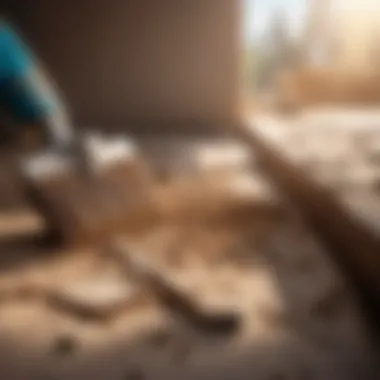Materials:
- Concrete mix: 20 bags of Quikrete High Strength Concrete Mix (80lb each)
- Masonry trowel: Marshalltown 11-in Brick trowel
- Cement mixer: Kushlan 350DD Cement Mixer
- Level: Stabila 48-inch Classic Level
- Safety gear: Hard hat, work gloves, safety glasses, and dust mask
DIY Steps:
-
Assess the Damage: Begin by inspecting the cracked foundation for the severity of the issue. Look for horizontal cracks, stair-step cracks, or diagonal cracks exceeding ¼ inch wide.
-
Excavate the Area: Use a shovel to dig around the cracked foundation, creating a trench that is at least 2 feet deep and 1-foot wide around the damaged area.
-
Prepare the Concrete Mix: In the cement mixer, combine the Quikrete High Strength Concrete Mix with water according to the manufacturer's instructions until you achieve a thick, workable consistency.
-
Fill the Crack: Using the masonry trowel, carefully fill the crack in the foundation with concrete mix, ensuring it is fully packed and leveled with the surrounding surface.
-
Smooth and Cure: Smooth out the surface of the filled crack with the trowel, ensuring a neat finish. Allow the concrete to cure as per the manufacturer's guidelines before proceeding.
Technical Aspects:
-
Tools: Ensure to have all necessary tools ready before starting the repair, such as masking tape, wire brush, and plastic sheeting.
-
Timing: Plan the repair on a dry day with moderate temperatures, avoiding extreme heat or cold that may affect the curing process.
-
Techniques: When filling the crack, avoid overfilling or leaving voids, as this can weaken the repair. Use the level to ensure a flush finish with the existing foundation.
DIY Project Process:


-
Sequential Steps:
- Assessment: Carefully examine the crack to determine the best approach for repair.
- Preparation: Dig around the crack and prepare the concrete mix for filling.
- Application: Fill the crack with the mix, ensuring proper compaction and finish.
- Curing: Allow the concrete to cure and strengthen over the recommended time.
-
Troubleshooting Tips:
- If the mix is too dry, add water gradually to achieve the right consistency.
- In case of hairline cracks, use a caulk gun and concrete repair sealant for a more precise repair.
- If the weather conditions are unfavorable, consider using protective covers or tenting to shield the repair from external elements.
Introduction


A cracked foundation can be a homeowner's nightmare, signaling potential structural issues that require immediate attention. In this pivotal segment of the comprehensive guide on dealing with a cracked foundation, we delve into critical aspects ranging from identifying warning signs to implementing effective repair and prevention strategies. Understanding the severity of the issue is paramount to safeguarding the integrity of your home.
Understanding the Severity of the Issue
-
What causes foundation cracks? Foundation cracks can stem from various factors, including water penetration, soil settlement, or improper construction practices. The presence of expansive soils or poor drainage around the foundation can exacerbate the risk of cracks forming, compromising the stability of the structure. It is imperative to grasp the root causes of foundation cracks to address them effectively, ensuring the longevity of your home.
-
Why is it crucial to address them promptly? Addressing foundation cracks promptly is crucial to prevent further structural damage and escalating repair costs. Neglecting these issues can lead to more extensive and expensive repairs down the line, potentially jeopardizing the safety of occupants. By addressing foundation cracks promptly, you can mitigate risks and preserve the structural integrity of your property.
-
Signs of structural damage to watch out for Signs of structural damage, such as uneven floors, cracked walls, or doors and windows that no longer close properly, should not be overlooked. These indicators suggest underlying foundation issues that need immediate attention. By proactively identifying and addressing these warning signs, homeowners can protect their investment and ensure the safety of their living environment.
Initial Assessment
-
Examining the extent of the crack Conducting a thorough examination of the crack is essential to determine its severity and potential impact on the overall structure. Assessing the length, width, and depth of the crack provides valuable insight into the extent of the damage, guiding subsequent repair efforts effectively.
-
Determining if professional intervention is necessary Deciding whether professional intervention is necessary requires a nuanced understanding of the crack's complexity and the expertise required for adequate repairs. Consulting with a qualified professional can help homeowners navigate this decision-making process and ensure the timely and appropriate resolution of foundation issues.
-
Documenting the damage Documenting the damage through photographs or detailed notes is crucial for tracking the progression of foundation cracks over time. This documentation serves as a reference point for monitoring changes and communicating effectively with contractors or inspectors during the repair process.
Safety Precautions
-
Secure the area around the crack Securing the area around the crack involves creating a safe and accessible workspace for conducting repairs. Clearing debris, establishing proper lighting, and ensuring adequate ventilation are essential safety measures to prevent accidents and facilitate efficient repair work.
-
Potential risks associated with a damaged foundation The risks associated with a damaged foundation extend beyond structural concerns to include potential hazards to occupants' safety. Addressing these risks promptly can mitigate the threat of collapse or other structural failures, safeguarding the well-being of individuals residing in the home.
-
When to evacuate the premises In severe cases where the structural integrity of the property is compromised, evacuating the premises may be necessary to protect occupants from potential harm. Prioritizing safety and recognizing when evacuation is warranted demonstrates a proactive approach to resolving foundation issues and ensuring the welfare of residents.
Repair Options


When dealing with a cracked foundation, understanding the repair options available is crucial for effective resolution. This section delves into the essential aspects of repair options, providing invaluable insights into how homeowners can address foundation issues promptly and efficiently.
DIY Repair Techniques
Materials needed for basic repairs
In the realm of DIY foundation repair, having the right materials is paramount. Basic repairs often require materials such as epoxy injection kits, concrete patching compound, and waterproof sealant. These materials play a pivotal role in reinforcing and sealing cracks, ensuring structural integrity is restored. The key characteristic of these materials lies in their durability and ease of application, making them popular choices for minor foundation repairs. While these materials offer cost-effective solutions, it's essential to acknowledge their limitations. DIY repair kits may not be suitable for extensive or structural damage, necessitating professional intervention.
Step-by-step guide for minor crack fixes
Navigating through a step-by-step guide for minor crack fixes empowers homeowners to tackle foundation issues confidently. By first cleaning the cracked area and injecting epoxy or applying patching compound, individuals can effectively mitigate crack expansion and water infiltration. The unique feature of this approach lies in its simplicity and accessibility, allowing homeowners to address minor cracks promptly. However, it's vital to recognize that while DIY solutions can offer temporary relief, they may not suffice for long-term structural stability. Regular inspections and professional evaluations are crucial for detecting potential risks and ensuring comprehensive repair.
Limitations of DIY approaches
Despite the convenience and cost-effectiveness of DIY approaches, they come with inherent limitations. DIY solutions may lack the expertise and technology required to assess and address complex foundation issues adequately. While DIY kits provide immediate fixes for minor cracks, they may overlook underlying structural concerns that could lead to recurring problems. It's essential for homeowners to understand the boundaries of DIY repairs and recognize when professional services are necessary to safeguard their property's foundation.
Preventive Measures
In this article, the preventive measures section plays a crucial role in empowering housewives and house owners to safeguard their homes against the potential risks associated with a cracked foundation. By focusing on regular upkeep and proactive strategies, individuals can take charge of maintaining their property's structural integrity. Emphasizing preventive measures is paramount in avoiding costly repairs and ensuring the long-term stability of the foundation.
Maintenance Practices
How to Prevent Foundation Issues Through Regular Upkeep
When discussing how to prevent foundation issues through regular upkeep, the key lies in implementing a routine maintenance schedule that includes inspecting for warning signs regularly. By addressing minor concerns promptly, homeowners can prevent small cracks from developing into significant structural issues. This practice not only enhances the property's value but also provides peace of mind to residents. Incorporating regular upkeep into the household maintenance routine is a wise investment in the property's longevity.
Drainage Management Tips
Effective drainage management is vital for maintaining a sturdy foundation. By ensuring proper water flow away from the property, homeowners can prevent excess moisture from accumulating near the foundation and causing damage. Implementing drainage solutions such as gutter extensions and surface grading can mitigate the risks of erosion and water seepage, thus preserving the foundation's stability. While drainage management requires regular attention, its benefits in preventing foundational issues outweigh the maintenance efforts required.
Landscape Adjustments for Better Foundation Stability
Landscape adjustments can significantly contribute to enhancing the stability of a property's foundation. By choosing suitable plants that complement the soil type and root depth, homeowners can create a balanced landscape that minimizes the risk of foundation damage. Additionally, strategic placement of trees and shrubs away from the foundation can prevent roots from exerting pressure on the structure. Incorporating landscape adjustments not only adds aesthetic value to the property but also reinforces its structural resilience.
Monitoring Techniques
Using Technology to Detect Early signs of Foundation Problems
Employing advanced technology, such as foundation movement sensors and moisture detection devices, enables early detection of potential foundation issues. By leveraging these tools, homeowners can identify subtle changes in the foundation's condition and address them proactively. Investing in technological monitoring solutions provides a proactive approach to foundation maintenance, allowing for timely interventions and preventing costly repairs down the line.
When to Conduct Routine Inspections
Establishing a regular schedule for foundation inspections is essential for detecting any structural changes promptly. Homeowners should conduct comprehensive assessments at least twice a year to monitor the foundation's condition and address any emerging issues early on. By adhering to a disciplined inspection routine, individuals can stay ahead of potential problems and preserve the integrity of their property's foundation. Consistent inspections serve as a vital component of proactive maintenance practices.
Professional Evaluation Importance
Seeking professional evaluations from experienced contractors or structural engineers is critical in ensuring the longevity of a property's foundation. Professionals can provide expert insights into the foundation's condition, identify underlying issues, and recommend appropriate remedial actions. While professional evaluations may incur additional costs, their value in addressing complex foundation issues and offering tailored solutions cannot be overstated. Prioritizing professional assessments underscores a commitment to maintaining a structurally sound home.
Foundation Reinforcement
Options for Strengthening a Weakened Foundation
When considering options for strengthening a weakened foundation, homeowners can explore techniques such as underpinning, piling, or wall anchor systems. By reinforcing the foundation's structural integrity, these methods can rectify existing issues and prevent future deterioration. Each reinforcement option has unique characteristics and benefits, tailored to specific foundation conditions. Selecting the most suitable reinforcement approach is pivotal in enhancing the foundation's stability and longevity.
Long-term Solutions for Structural Stability
Opting for long-term solutions, such as foundation encapsulation or integrated drainage systems, offers sustained protection against foundation damage. These comprehensive measures address underlying factors contributing to foundation instability, ensuring durable structural support for the property. Long-term solutions provide homeowners with peace of mind, knowing that their foundation is fortified against common vulnerabilities and environmental challenges. The investment in structural stability pays off in the form of a resilient and secure living environment.
Factors Influencing Foundation Integrity
Various factors, including soil composition, climate conditions, and construction materials, influence the integrity of a foundation. Understanding how these elements interact and impact the foundation is critical for implementing effective reinforcement strategies. By evaluating the specific factors that affect foundation stability, homeowners can make informed decisions regarding maintenance practices and structural upgrades. Recognizing the pivotal role of these influencing factors is essential in safeguarding the foundation against potential risks and ensuring its long-term durability.
Conclusion
In the realm of home maintenance, addressing foundation cracks promptly emerges as a critical and non-negotiable task. Neglecting such structural issues can lead to severe consequences, impacting the overall stability and safety of a residence. By examining warning signs, taking meticulous repair actions, and implementing preventive measures, homeowners can safeguard their homes for the long term. The persuasive data and expert opinions shared in this article underpin the gravity of swift intervention when foundation cracks surface, reiterating that proactive measures are the cornerstone of a secure household.
Final Thoughts
Importance of addressing foundation cracks promptly
Essential to every homeowner, the importance of addressing foundation cracks promptly cannot be overstated. It serves as the first line of defense against escalating structural damage and financial repercussions. By prioritizing prompt action, individuals protect their investment, ensuring the longevity and value of their property. This article underscores the significance of this aspect by examining case studies and real-life scenarios, emphasizing the tangible benefits that prompt intervention brings to the table. While the task may seem daunting, the rewards of quick resolutions far outweigh the initial challenges, making it a standard practice for prudent homeowners.
Long-term implications of neglecting structural issues
Conversely, neglecting structural issues can have far-reaching consequences that extend beyond mere cosmetic appearance. A failure to address foundation cracks in due time can result in compromised structural integrity, compromising the safety of inhabitants. Through a detailed exploration of the domino effect triggered by such neglect, this article sheds light on the stark contrast between proactive maintenance and reactive crisis management. Understanding the preventable catastrophes that stem from ignoring these issues serves as a cautionary tale, prompting readers to take heed and avert potential disaster through timely interventions.
Seeking professional guidance for complex problems
Navigating the complexities of foundation issues often necessitates the expertise of professional contractors. Seeking professional guidance ensures that problems are accurately diagnosed, addressed with appropriate measures, and future-proofed against recurring damage. Transparent guidance on selecting reputable contractors and discerning red flags empowers readers to make informed choices when faced with intricate foundation issues. While the cost implications of professional services may be a consideration, the long-term benefits of expert intervention in navigating complex problems far outweigh the initial investment, positioning it as a strategic and value-driven decision for homeowners confronting structural challenges.





